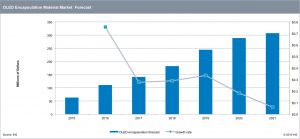
The active-matrix organic light-emitting diode (AMOLED) display market continues to increase its share of the overall display market, reaching 11 percent of display shipments in 2016 and rising to 22 percent in 2020. To support this rapid growth, the AMOLED encapsulation material market is expected to grow 76 percent year over year to reach $111 million in 2016.
AMOLED encapsulation is a key technology that determines the lifespan and reliability of smartphones, TVs and other devices that include AMOLED displays. Because AMOLED organic materials are highly vulnerable to moisture and oxygen, AMOLED encapsulation is essential to protect devices from physical shocks.
AMOLED encapsulation surface area is expected to rise 62 percent year over year to reach four million square meters in 2016. Double-digit growth will continue, reaching 13 million square meters in 2020.
Following are the primary technologies used in the AMOLED encapsulation process:
- Glass encapsulation: used primarily in smartphone displays and other small displays that require a slim form factor, glass encapsulation AMOLED materials will dominate the the market in 2016.
- Metal encapsulation: In the early stages of AMOLED development, metal encapsulation was used for smartphone AMOLED displays. It is also currently widely used in AMOLED TV displays.
- Thin-film encapsulation (TFE): For flexible displays used in wearables and other devices, TFE has become more popular recently.
Glass encapsulation is expected to comprise more than half (56 percent) of the total encapsulation market, reaching $62 million in 2016. However, with rising demand for AMOLED TVs requiring much larger display surface area than smaller smartphone and wearable devices, metal encapsulation is expected to overtake glass encapsulation, to reach 53 percent of the market in 2017.

